Whether
it's puppies, kittens
or children, Nature
insists on play. Play is a requirement
for healthy development of a
loving personality as well as
for a healthy body. In addition,
play is the basis for a social
structure. Individuals of any
species that do not play when
they are young are severely
mentally and socially compromised
when they become adults.
Socializing
should begin no later than six weeks
in puppies.
 Pets
who learn to play early, and
play a lot, tend to retain that
playfulness later in life. This
has several benefits to the
pet:
Pets
who learn to play early, and
play a lot, tend to retain that
playfulness later in life. This
has several benefits to the
pet:
- Cardiovascular
development
-
Balance and coordination
-
Joint lubrication
-
Hunting and fighting skills
-
Easier and more fun for the
owner to exercise the pet
(e.g., throw a ball, or drag
a string).
-
More fun in life for the dog
-
Owner usually enjoys watching
(and participating), so pet
is more entertaining. This
increases the owner-animal
bond.
 Though
a related species, dogs play
more than wolves. In wolves,
play decreases soon after puberty.
In dogs, we have bred/selected
over time for playfulness to
continue throughout the animal's
life. This is no accident. Humans
have bred dogs for this "juvenile"
behavior, because we value playfulness
as a personality characteristic
in pets. We should provide toys
and encourage non-destructive
play as much as possible, starting
as early in life as possible.
Though
a related species, dogs play
more than wolves. In wolves,
play decreases soon after puberty.
In dogs, we have bred/selected
over time for playfulness to
continue throughout the animal's
life. This is no accident. Humans
have bred dogs for this "juvenile"
behavior, because we value playfulness
as a personality characteristic
in pets. We should provide toys
and encourage non-destructive
play as much as possible, starting
as early in life as possible.
 In genetics, when a juvenile trait is selectively bred, the resulting species is said to be "neotenized."
One animal behaviorist jokingly
wondered aloud, "Are humans
really neotenized chimpanzees?"
In genetics, when a juvenile trait is selectively bred, the resulting species is said to be "neotenized."
One animal behaviorist jokingly
wondered aloud, "Are humans
really neotenized chimpanzees?"
Aggressive
Play
 Play
fighting between puppies usually
does not result in an aggressive
adult dog. It's a way
for puppies to determine their
rank in the litter and for adult
dogs to cement theirs with the
pack. However, rough play between
people and dogs over 6 months
often turns out badly. The aggressive
threshold is lowered because
the dog is rewarded by the fun
of growling and tooth grabbing
a human. Guard dog breeds have
a genetically lower aggressive
threshold, so they love the
rough play, but are also more
likely to escalate the aggression
later, but usually toward a
different human.
Play
fighting between puppies usually
does not result in an aggressive
adult dog. It's a way
for puppies to determine their
rank in the litter and for adult
dogs to cement theirs with the
pack. However, rough play between
people and dogs over 6 months
often turns out badly. The aggressive
threshold is lowered because
the dog is rewarded by the fun
of growling and tooth grabbing
a human. Guard dog breeds have
a genetically lower aggressive
threshold, so they love the
rough play, but are also more
likely to escalate the aggression
later, but usually toward a
different human.
|
Aggressive
play allows the
dog to show aggressive symptoms
toward humans, and enjoy
doing it! Aggressive
play in puppies may also lead
to aggression in adults. |
Dog
Play Body Language
 Dogs
use a variety of body language
signals to display playfulness.
An individual dog may show any
combination of these play signals:
Dogs
use a variety of body language
signals to display playfulness.
An individual dog may show any
combination of these play signals:
-
Play Bow
- Slapping both front legs
on the ground with the rump
up in the air.
-
Exaggerated Looking
Away - Focusing
on you while pretending to
look away
-
Pawing With Front Paw
- This is the solicitation
gesture; roughly means "Please."
-
Prancing ZIG And Zag Leaps -
Lots of energy and joy.
-
Chase Behavior
- Canine equivalent of starting
a tag game
-
Play Facial Expression
- Distinct once you start
looking for it
-
Frequent Role
Reversal -
Pushy
dogs acting submissive to
signal non-threatening play
|
Actively
encourage your dog to engage
in appropriate play from
an early age. Rotate two or three safe toys to
play with each day.
Praise any interest or chewing
on toys. |
Rules
Of Fair Play When Playing With
Your Dog
 Here
are four guidelines for appropriate
dog play. These are basic rules;
if your dog violates any of
them, stop the play for at least
30 seconds i.e. give the dog
a "time out" then
require a SIT before resuming
play. Train him or her to "play
fair" by these rules:
Here
are four guidelines for appropriate
dog play. These are basic rules;
if your dog violates any of
them, stop the play for at least
30 seconds i.e. give the dog
a "time out" then
require a SIT before resuming
play. Train him or her to "play
fair" by these rules:
1) No canine teeth grab skin
or clothes. Never permit aggressive
play with tooth contact.
2) Human decides on beginning
and ending of play session (to
retain leadership).
3) Human usually wins,
but it is fun when the dog wins
occasionally also.
4) If the dog wants to play
more than the human, redirect
his energy into a chew toy.
Safe
Games To Play With Your Dog
Tag:
I touch you, then
you touch me. (No teeth!) Kids
especially love this game.
Hide
and Seek: Can
you find where I hid your bone
(toy)? Can you find me at the
dog park after dark? Kids can
play this game: Give a ¼
inch piece of hot dog. Tell
the dog STAY. Run and hide,
then yell come. When the dog
finds you, say SIT, give another
piece, then repeat STAY. If
the dog does not stay, it is
time for an obedience refresher
course.

Fetch:
Ball or flying disc. Praise
anything close at first, then
praise more specifically. Start
with the dog right in front
of you, and teach TAKE IT and
DROP IT. If the dog will not
drop the toy, have a second
ball, and trade for the one
the dog has.
Grooming:
Pretend to prepare the dog for
an appearance as the star of
a TV commercial.
Wrestling:
This is the same as restraint
and handling. The goal is to
get the dog to "Give"
in several different positions.
Make sure you win at the end
of the game.
Tug
of War:
Follow basic
rules above. Use an owner designated
toy.
Explorer:
Leash or harness the dog and
discover wilderness (or your
neighborhood) together.
 In
the final analysis, play is
a great way to spend time with
your pets, and when done correctly
actually contributes to the
mental health of all involved.
In
the final analysis, play is
a great way to spend time with
your pets, and when done correctly
actually contributes to the
mental health of all involved.